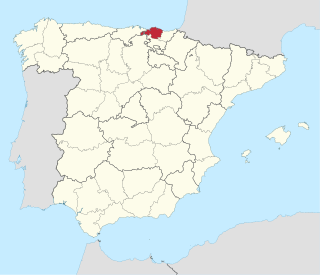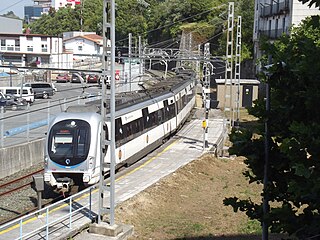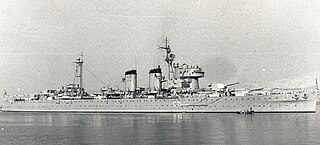
Biscay is a province of Spain and a historical territory of the Basque Country, heir of the ancient Lordship of Biscay, lying on the south shore of the eponymous bay. The capital and largest city is Bilbao.

Euskotren Trena, formerly known just as Euskotren is a commuter, inter-city and urban transit train-operating company that operates local and inter-city passenger services in the provinces of Biscay and Gipuzkoa, in the Basque Country, Spain. It is one of the four commercial brands under which Euskotren operates, as a public company managed by the Basque government. The entire 181.1-kilometre (112.5 mi) network uses 1,000 mm narrow gauge rail tracks which have been owned by the Basque Government since their transferral from the Spanish government; the rail tracks and stations were part of the FEVE network until its transferral. Euskotren Trena also operates the Donostia/San Sebastián metro under the brand Metro Donostialdea.
In 1937, the Nationalists, under the leadership of Francisco Franco began to establish their dominance. An important element of support was their greater access to foreign aid, with their German and Italian allies helping considerably. This came just as the French ceased aid to the Republicans, who continued, however, to be able to buy arms from the Soviet Union. The Republican side suffered from serious divisions among the various communist and anarchist groupings within it, and the communists undermined much of the anarchists' organisation.
The Battle of Cape Spartel was a naval battle of the Spanish Civil War that broke the Republican naval blockade of the Strait of Gibraltar, securing the maritime supply route to Spanish Morocco for the Nationalists early in the war. The action occurred on 29 September 1936 between two Nationalist cruisers and two Republican destroyers.

The Battle of Cape Cherchell was a naval battle between the Nationalist heavy cruiser Baleares and the Spanish Republican Navy light cruisers Libertad and Méndez Núñez in the Spanish Civil War, several miles north of the Algerian city of Cherchell. In the early morning hours of 7 September 1937, Baleares unexpectedly met a Republican convoy consisting of two merchant ships escorted by Republican cruisers and destroyers. Baleares was beaten off and badly damaged in the engagement, but the merchantmen were lost when they tried to slip away along the Algerine shoreline.

The War in the North was the campaign of the Spanish Civil War in which the Nationalist forces defeated and occupied the parts of northern Spain that had remained loyal to the Republican government.

Basque Y is the high-speed rail network being built between the three cities of the Basque Autonomous Community, in Spain; Bilbao, Vitoria-Gasteiz and Donostia-San Sebastián.

The campaign of Gipuzkoa was part of the Spanish Civil War, where the Nationalist Army conquered the northern province of Gipuzkoa, held by the Republic.

Júpiter-class minelayers was a group of four vessels of the Spanish Republican Navy built during the Spanish Republic. Three of them came into service during the Civil War after joining the rebel side.

José Luis Díez was a Churruca-class destroyer in the Spanish Republican Navy. She took part in the Spanish Civil War on the government side.

Almirante Cervera was a light cruiser and lead ship of the Almirante Cervera class of the Spanish Navy. She was named after the Spanish admiral Pascual Cervera y Topete, commander of the Spanish naval forces in Cuba during the Spanish–American War. She was part of the Spanish Republican Navy between 1931 and 1936, year in which she became a key player of the Nationalist Fleet in the Spanish Civil War.

Canarias was a Canarias-class heavy cruiser of the Spanish Navy. She was built in Spain by the Vickers-Armstrongs subsidiary Sociedad Española de Construcción Naval based on a British design, being a modified version of the Royal Navy′s County class. Canarias saw service during the Spanish Civil War.

Baleares was a Canarias-class heavy cruiser of the Spanish Navy whose control was taken by the Nationalist side during the Spanish Civil War. The two ships of the class were built upon a British design and were a modified version of the Royal Navy′s County class. Baleares was constructed in Spain by the Vickers-Armstrongs subsidiary Sociedad Española de Construcción Naval, and saw service during the Spanish Civil War, when she was torpedoed and sunk by destroyers of the Spanish Republican Navy during the Battle of Cape Palos.

Mar Negro was an armed merchantman of the Nationalist Spanish Navy during the Spanish Civil War. The cargo ship was launched in 1930 along with her sister ship MV Mar Cantábrico, and after five years with the Compañía Marítima Del Nervión company, she was requisitioned by the Spanish Republican Navy in 1936. Captured by a group of Nationalist sympathizers from her crew off Algeria in 1937, she entered in service in 1938 after being converted to an auxiliary cruiser.

Manuel Carrasco i Formiguera, was a Spanish lawyer and Christian democrat Catalan nationalist politician. His execution, by order of Francisco Franco, provoked protests from Catholic journalists such as Joseph Ageorges, the President of the International Federation of Catholic Journalists. Ageorges wrote, "Even more than the death of the Duke of Enghien stained the memory of Napoleon, the death of Carrasco has stained the reputation of Franco". Such protests, in turn, provoked the anger of the Francoist press. His funeral in Paris on 27 April 1938 was attended by many notable people, including Joan Miró, Ossorio y Gallardo, Josep M. de Sagarra, Joaquim Ventalló and Jacques Maritain and his wife Raissa.

The Biscay Campaign was an offensive of the Spanish Civil War which lasted from 31 March to 1 July 1937. 50,000 men of the Eusko Gudarostea met 65,000 men of the insurgent forces. After heavy combats the Nationalist forces with a crushing material superiority managed to occupy the city of Bilbao and the Biscay province.

The Spanish Republican Navy was the naval arm of the Armed Forces of the Second Spanish Republic, the legally established government of Spain between 1931 and 1939.

The Basque Auxiliary Navy was a section of the Spanish Republican Navy operating in the Bay of Biscay between 1936 and 1937. The naval force began their operations in October 1936 at the behest of the autonomous Basque Government. The main Basque Navy base was at Portugalete.

Cabo Machichaco was an iron-hulled cargo steamship that was built in England in 1882 as Benisaf, and renamed Cabo Machichaco in 1886. She was destroyed by two explosions in her cargo in 1893 and 1894 in the port of Santander, Spain. The first explosion killed several hundred people in the city of Santander as well as on the ship, and was Spain's worst peacetime disaster in the 19th century. The second explosion killed a number of workers who were salving the remainder of her cargo from her sunken wreck.

















